Thursday, September 25, 2014
I was attending a neurology symposium in Erbil (Hawler), the capital of Iraqi Kurdistan. ِAfterwards, I headed to one of my relatives’ to pay him a visit; my family was with me. My relatives insisted we should stay in their home and spend a couple of days with them. And I thought, why not! At night, I surfed the net about rock reliefs in Iraqi Kurdistan and found one result that told of a relief in the village of Hareer called Rock Relief of Harir (Arabic: منحوتة حرير; Kurdish: نه خشي هه رير). I wondered what it was. I tried desperately to find any additional useful information about this relief, but I was unsuccessful!
Friday, September 26, 2014
My relative, Dana Hiwa and I drove my car to the village of Hareer (or Harir; Arabic حرير; Kurdish هه رير). It was north to the city of Hawler about an hour and a half by car (36°33’48.47″N; 44°20’53.52″E). As there were no clues, I was not able to find the precise location of the relief. I asked many local villagers about it; they were somewhat suspicious and I received no answer. Finally, around 1:00 PM I called my dear friend, Mr. Hashim Hama Abdullah (director of the Sulaymaniyah Museum). He replied positively and told me that an archaeologist who lived nearby could help me out; Mr. Hashim phoned him. After five minutes the archaeologist, Mr. Hemin Rashid called me and asked where I was. He arrived in 15 minutes.

The village of Hareer, Erbil Governorate, Iraqi Kurdistan. Shooting from Mountain Harir. Photo © Osama S. M. Amin
I parked my car near a house, Mr. Hemin told the house’s residents that we were heading to the relief, up in the mountain. The relief was not far, and thankfully it was not an exhaustive climb. There was a sign which described the relief in three languages (Kurdish, Arabic, and English); it was placed at the foot of the mountain.
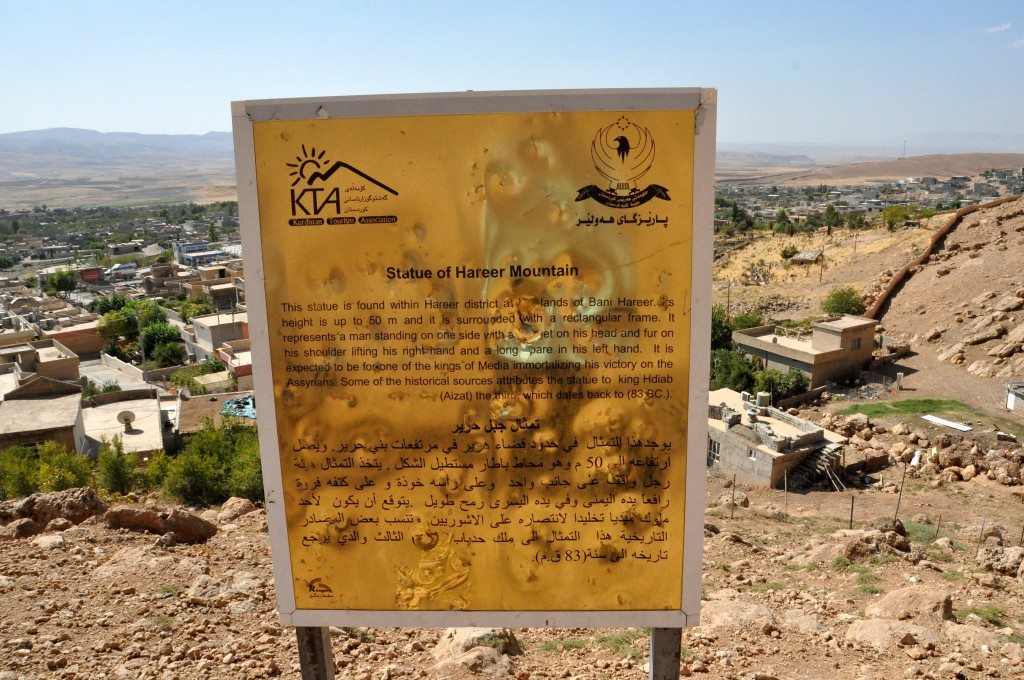
This sign mentions the Kurdistan Tourism Association and The Governorate of Hawler. It describes the relief in 3 different languages (English and Arabic; the back side of the plate was written in Kurdish). The sign lies at the foot of the mountain. Note the village in the background. Photo © Osama S. M. Amin.
After a few minutes, we started to see the relief. It is about 50 m from the mountain’s foot and 80 m from the street level. A flag of Kurdistan was painted about 2 m above the relief.
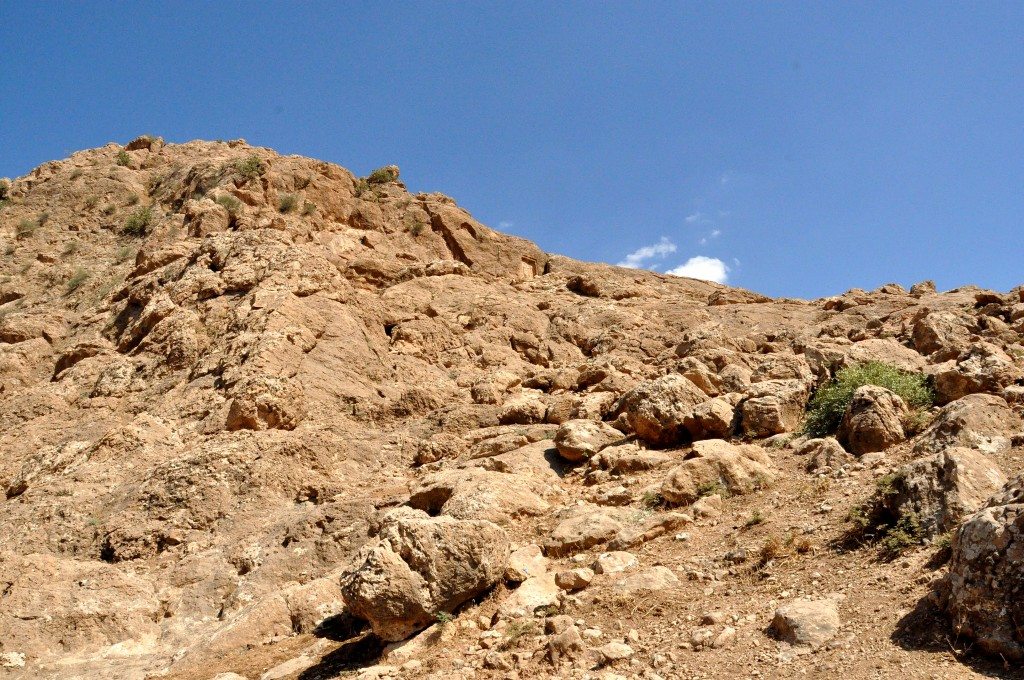
The rock-relief (carved rectangle) can be seen at the middle of the picture, below the upper margin of the mountain’s summit. Exclusive Photo © Osama S. M. Amin.
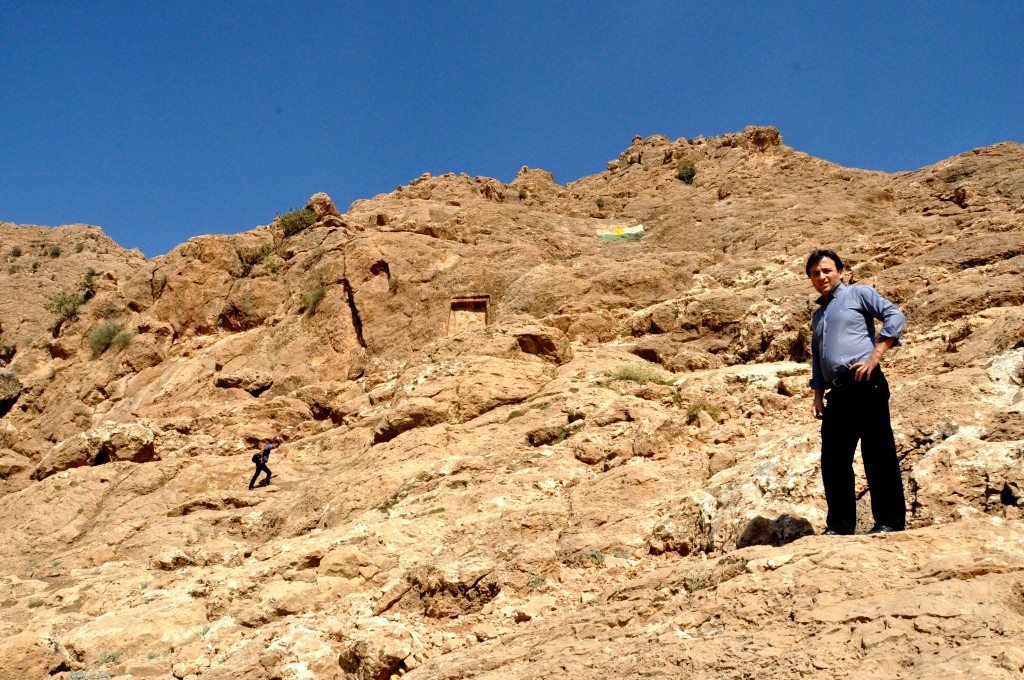
Approaching the relief. Dana Hiwa (left, my relative) and Mr. Hemin Rashid (right). Note the flag of Iraqi Kurdistan. Exclusive Photo © Osama S. M. Amin.
The relief
The relief is commonly known as the Harir, Batas (BĀṬĀS)-Harir rock relief, or Batas relief. The relief lies on the cliff of Mountain Harir; the latter looks over a large village of the same name (Harir/Hareer). The relief lies north-east of the village. In 1899 CE, C. F. Lehmann-Haupt was the first one who documented the presence of this relief and described it in a publication in 1926 CE; no photograph of the relief was included. In 1931 CE, C. J. Edmonds published an article which contained a photograph of the relief with a description of the main figure.
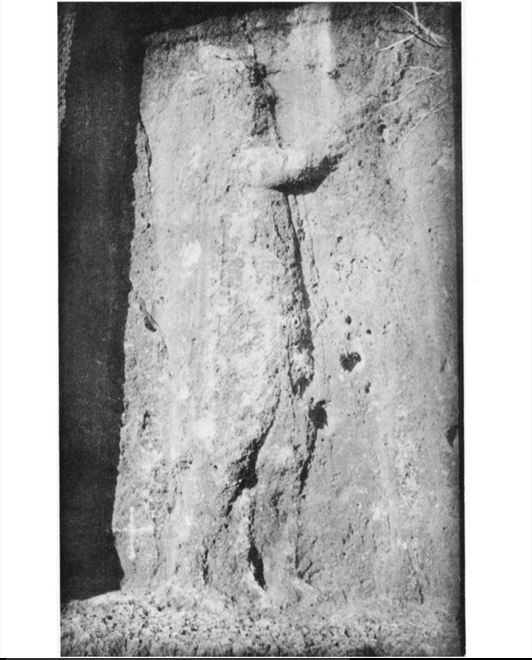
Scanned picture of “Batas relief.” Source: C. J. Edmonds. “A Third Note on Rock Monuments in Southern Kurdistan.” Geographical Journal 77, 1931, pp. 350-55. The image was taken in April 1926 CE by C. J. Edmonds.
The scanned image reveals recognisable body contours on the relief, although it was mutilated and generally not in good condition. The main figure is an adult male. The man is depicted in profile, standing and appears to be walking south.
Cecil John Edmonds (1889-1979 CE), described the relief precisely and impressively:
“The relief is very worn and occupies a panel excavated in the rock a foot or more deep. This panel, which is decorated on the outside edge by a shallow frame, and on the inside by a beveled mounting, so to speak, 8 inches wide, measures: base 6 feet 8 inches; height 9 feet 6 inches; top 5 feet 6 inches. The figure is 8 feet tall and 1 foot 8 inches across the chest; it looks to the spectator’s right; the right arm is outstretched, with the hand level with the face and holding some unrecognizable object; a long cloak seems to hang from the shoulder; below the cloak is a shirt-like garment looped up in front, apparently into a low belt, giving the effect of very baggy trouser; the calves are flat and muscular; the face and headdress are badly mutilated, but the latter seems to be a highish conical cap with two horns, one blunt, sticking out behind. The figure has been maliciously damaged, mostly by rifle fire; one scar was evidently recent at the time of my visit.” (source: “A Third Note on Rock Monuments in Southern Kurdistan.” Geographical Journal 77, 1931, pp. 350-55).
Edmonds did not describe the left hand or whether there is any other object. The hidden hand (behind the torso) holds a long staff; the lower end touches the ground while the upper end is that of a spear or it was capped with a device of four superimposed balls. It is not clear whether the right hand/arm was raised in a greeting or prayer. Within or outside the relief, no inscriptions or signs were found.
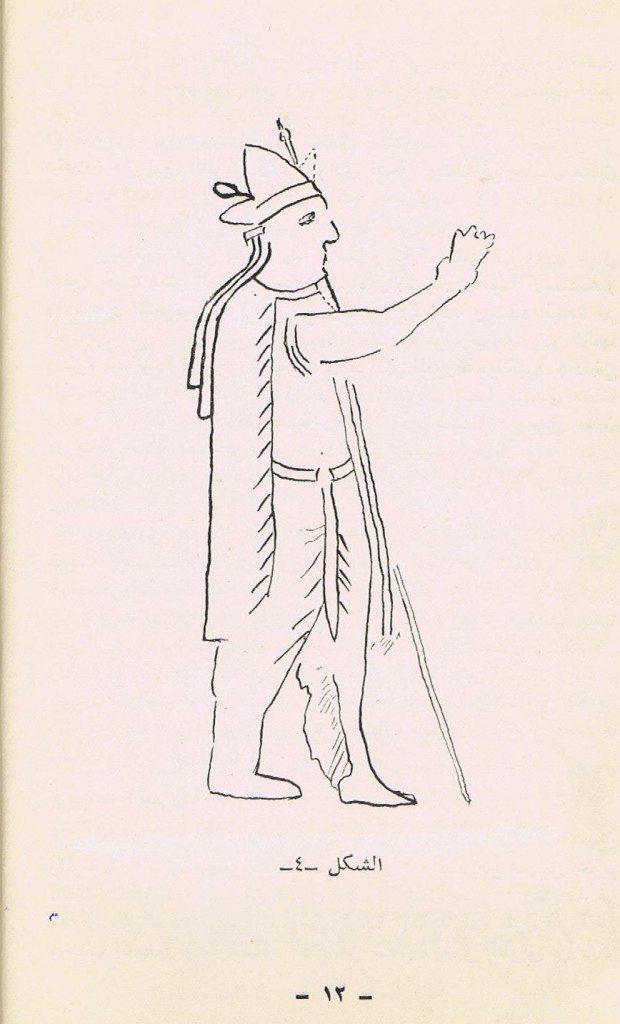
Scanned sketch of the main figure of Harir’s rock relief. From the book of Professors Taha Bakir and Sami’e Safr: 1966 (المرشد الى مواطن الاثار والحضارة الرحلة الخامسة (بغداد اربيل. Many thanks go to Mr. Hashim Hama Abdullah for providing me with this image.
Which period does this relief belong to? There is no clear-cut answer. The dress of the man in the relief dates back to the Parthian period. The overall depiction of the relief and its main figure resemble those of the rock reliefs of Merquli and Rabana. Therefore, this man might well have been a local ruler within the Parthian empire. Some think that this is one of the Median kings, commemorating his victory against a military campaign of an Assyrian army. However, the sign at the foot of the mountain describes the man as King Hdiab (Aizat) III, 83 CE. The Encyclopedia Iranica states that the man is Izates II, King of Adiabene (36-62 CE), who was converted to Judaism. He is likely to have ordered the carving after the unexpected retreat of the Parthian King of Kings, Vologases I. However, M. Grabowski stated that “Despite the location of the relief, the image itself does not provide any grounds for associating the monument with Izates II or Vologases I’s retreat. The pose and gesture of the depicted figure suggest that the scene is most probably of a religious theme. If so, one would expect that the monument commissioned by a zealous follower of Judaism, such as Izates II, would contain at least some of the typical Jewish religious symbols such as the menorah, the shewbread table, the Torah shrine, or the Ark of Covenant.” (source: “ABDISSARES OF ASIABENE AND THE BATAS-HERIR RELIEF”. Swiatowit, 2011, IX (L)/A, pp 117-140).
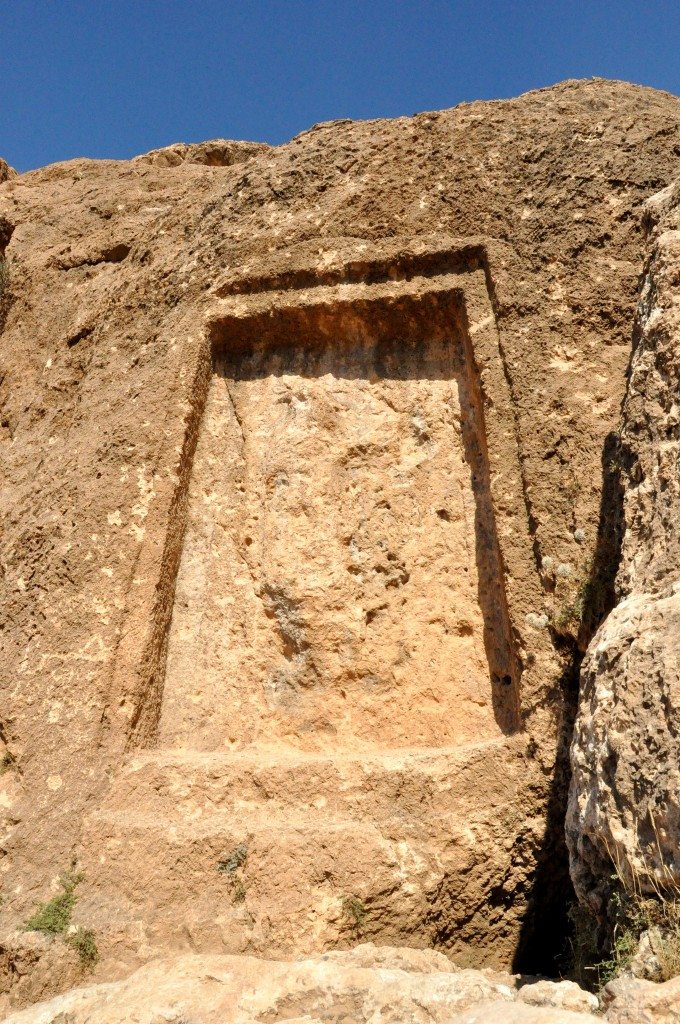
Rock relief of Harir, Mountain Harir, Erbil Governorate, Iraqi Kurdistan. Exclusive Photo © Osama S. M. Amin.
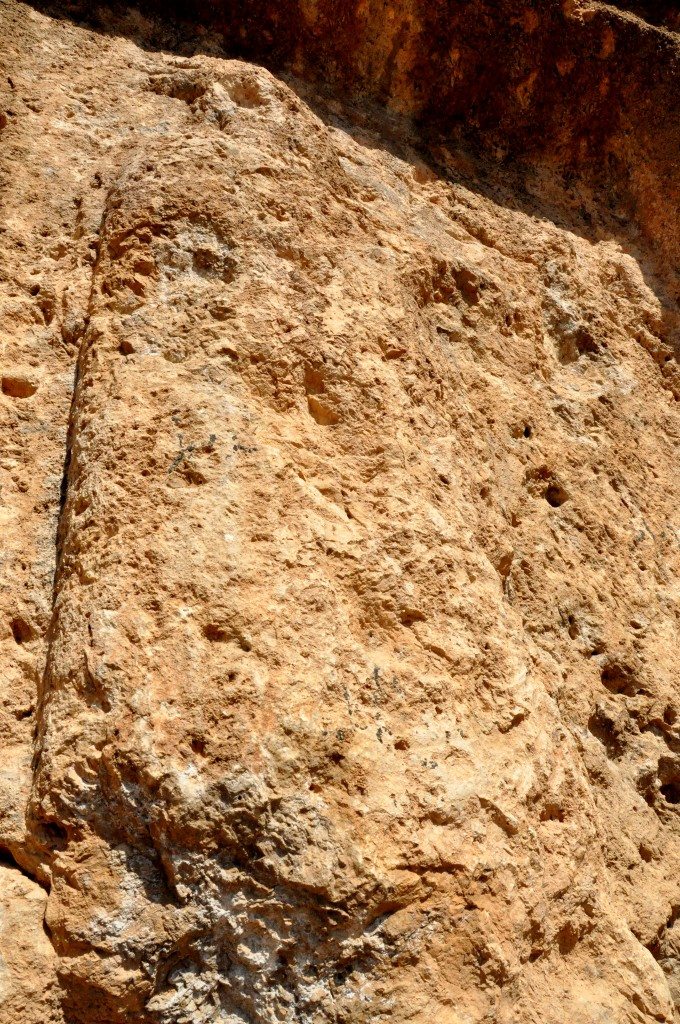
The depicted man of the relief. The figure on the relief suffered several mutilations and vandalism; note the bullet marks and the damage incurred by sledgehammers. Exclusive Photo © Osama S. M. Amin.
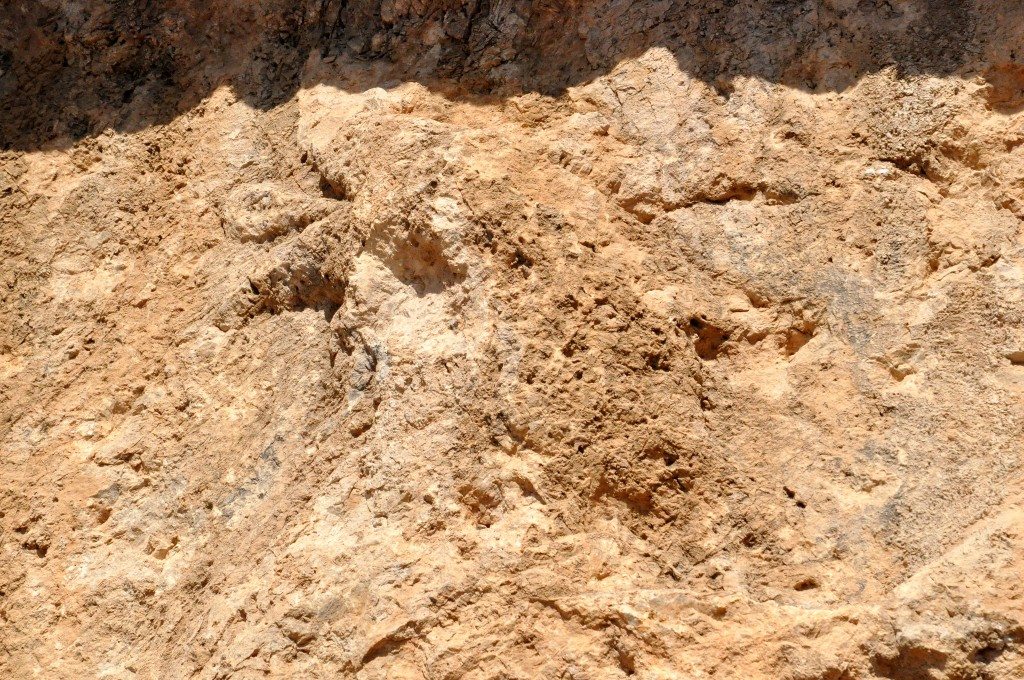
The head and shoulder of the man depicted on Mountain Harir’s rock relief. Note the large bullet mark on his head cap! Exclusive Photo © Osama S. M. Amin.
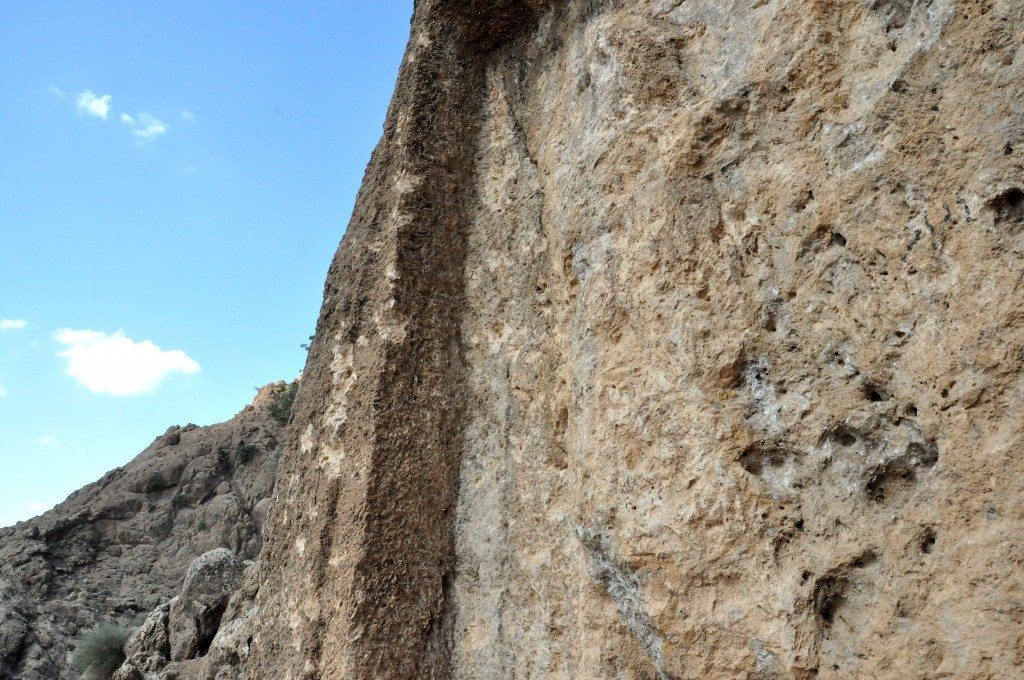
The rectangular margin of the relief is very prominent, the depth of the relief is 15 to 30 cm. The body of the relief’s figure stands out from the mountain’s wall and he had received innumerable bullets! Exclusive Photo © Osama S. M. Amin.
The Iraqi Kurdistan region contains many ancient mountainous rock reliefs, and in my opinion all of them have been overlooked by local researchers. The pertinent literature (found on the net) was published by western scholars. Thanks to those scholars who documented, described, and photographed these reliefs so that the rest of the world, including Iraqi people, can see what the land of Mesopotamia has inherited since the dawn of humanity.
Since 1958 CE (the downfall of the Iraqi Kingdom and the creation of the Republic of Iraq) the previous political governments in Iraq have, for [political] reasons beyond the scope of this article, intentionally concentrated (through their media and propaganda) on certain parts of Mesopotamian history (such as Babylon, Nimrud, and Nineveh). They deliberately ignored the archaeological sites in the north-east area of Iraq (so-called Iraqi Kurdistan or Southern Kurdistan), once again for reasons which are beyond this article. I found this article about Harir’s rock-relief in Kurdish published by a local journal (Sabartu) in 2009 CE. The article tries to describe and analyze the relief but its pictures are blurred and it is written in the Kurdish language. The article is generally superficial and has not added any useful/new information to the pertinent western-published literature, but at least it was a good “local” attempt to document the relief.
In order to write this article, I used the following sources:
- Personal interviews with Mr. Hashim Hama Abdullah (director of the Sulaymaniyah Museum) and Dr. Mouad Al-Damirchy (former general director of the General Directorate of Archaeology in Baghdad).
- C. J. Edmonds. “A Third Note on Rock Monuments in Southern Kurdistan.” Geographical Journal 77, 1931, pp. 350-55.
- C. J. Edmonds. “Two Ancient Monuments in Southern Kurdistan,” Geographical Journal 65, 1925, pp. 63-64.
- Maceij Grabowski. ABDISSARES OF ASIABENE AND THE BATAS-HERIR RELIEF. Swiatowit, 2011, IX (L)/A, pp 117-140. This is a recent and quite useful article.
My sincere gratitude goes to Mr. Hashim Hama Abdullah (director of the Sulaymaniyah Museum) and Mr. Hemin Rashid for their kind help and cooperation.
I’m deeply honored to say that I have visited, touched, documented, and published all rock reliefs of Iraqi Kurdistan (except a rock relief at the entrance of a temple at the village of Amedi, Dohuk Governorate).
These are:
- Rock relief of Naram-Sin at Darbad-i-Gawr (Arabic: النحت الصخري لنارام سين في دربندي گاور.; Kurdish: نه خشي نيرام سين له ده ربندي گاور).
- Rock relief of Belula Pass or Akkadian Rock relief at Darband-i-Belula (Kurdish: نه خشي ده ربندي بيلوله له هۆرێن و شێخان; Arabic: النحت الصخري في دربندي بيلوله في هورين- شيخان).
- Rock reliefs of Mountain Merquli and Mountain Rabana. Their article is under review by AHE at the time of submitting this article.
- And, last but not least, this article’s rock-relief of Batas-Harir.
Without the help of Ancient History Encyclopedia, my works would not have been published! Thank you!
Disclaimer:
Erbil (or Hawler) Governorate lies within the northern area of Iraq and is part of Iraqi Kurdistan (or Kurdistan Region or Southern Kurdistan). All of these terms are used to describe the region. Neither the author nor Ancient History Encyclopedia endorses any specific term of the aforementioned ones.
